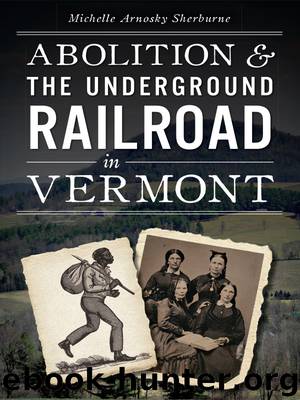Abolition and the Underground Railroad in Vermont by Michelle Arnosky Sherburne

Author:Michelle Arnosky Sherburne
Language: eng
Format: epub
Publisher: Arcadia Publishing Inc.
Published: 2013-07-07T16:00:00+00:00
The Morrises were selfless people, always willing to help someone in need. George S. Morris, Sylvester’s son, shared with college friend John L. Brewster about his father’s Norwich Underground Railroad safe house. George remembered as a boy going downstairs to breakfast, where a whole table of “colored people would be eating their breakfast—No member of the family ever asked a question about them as to when they came or were to go or when.” Brewster and George graduated in 1861, and years later, after George had died, Brewster wrote Siebert in 1896.
Up until 1826, the Strafford Turnpike was a heavily traveled route that ran from Boston to Burlington, continuing on to Montreal, Quebec. This made Strafford a busy junction for another form of traffic: two Underground Railroad routes. From the south, fugitive slaves came from Woodstock, and from the east, connections stemmed from the Lyme, New Hampshire route. Since the established turnpike continued to Chelsea, Morris’s guests traveled that way often.
Cone wrote about her grandfather’s fervor about the slavery issue: “Deacon Morris was our rough, hard-handed Abolitionist tanner. He was the local apostle of antislavery and temperance in the towns in which he lived…he took extreme and absolute ground.”
Morris was a native of Stafford, Connecticut. He married Susannah of Randolph, Vermont, in 1822, and their first years together in that state were in Barnard. He was a farmer but then got into the tanning business. They moved to Strafford in Vermont in 1827. They had ten children, and one of their sons, George, became a noted educator, philosophical writer and lecturer at University of Michigan and Johns Hopkins University.
Morris bought a tannery in South Strafford but may have lived in the village of South Strafford. In the 1830 census, he is listed among village households. The Morrises joined the Strafford Congregational Church in 1828, and four years later, Sylvester became a deacon of that church. The title of “deacon” became part of his name for the rest of his life, as he was referred to as “Deacon Morris.” Morris was an officer in the newly organized First Congregational Society of Strafford, and a new church was built in 1832.
The Morrises helped fugitives while living in Strafford and Norwich. Siebert recorded that while in Strafford, Morris transported fugitives to Moses Smith’s in Lyme, New Hampshire, or to Mr. Lord’s in Union Village.
Download
This site does not store any files on its server. We only index and link to content provided by other sites. Please contact the content providers to delete copyright contents if any and email us, we'll remove relevant links or contents immediately.
| General | Discrimination & Racism |
Nudge - Improving Decisions about Health, Wealth, and Happiness by Thaler Sunstein(6644)
iGen by Jean M. Twenge(4708)
The Fire Next Time by James Baldwin(4352)
Adulting by Kelly Williams Brown(3682)
The Sports Rules Book by Human Kinetics(3597)
The Hacking of the American Mind by Robert H. Lustig(3589)
The Ethical Slut by Janet W. Hardy(3513)
Captivate by Vanessa Van Edwards(3310)
Mummy Knew by Lisa James(3176)
In a Sunburned Country by Bill Bryson(2954)
The Worm at the Core by Sheldon Solomon(2929)
Ants Among Elephants by Sujatha Gidla(2929)
Suicide: A Study in Sociology by Emile Durkheim(2617)
The Slow Fix: Solve Problems, Work Smarter, and Live Better In a World Addicted to Speed by Carl Honore(2579)
Humans of New York by Brandon Stanton(2383)
Handbook of Forensic Sociology and Psychology by Stephen J. Morewitz & Mark L. Goldstein(2380)
Blackwell Companion to Sociology, The by Judith R. Blau(2320)
The Happy Hooker by Xaviera Hollander(2277)
Outliers by Malcolm Gladwell(2263)
